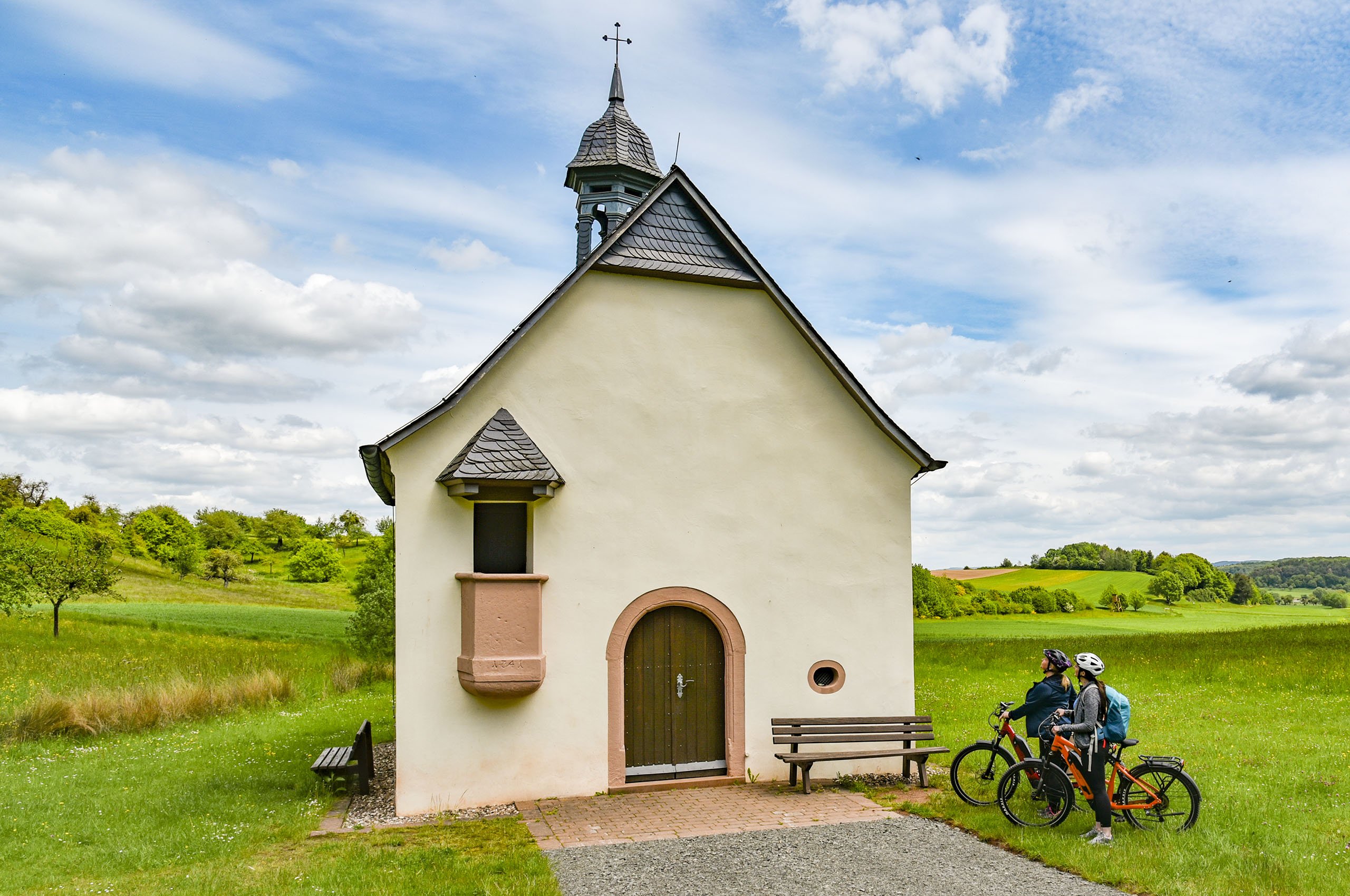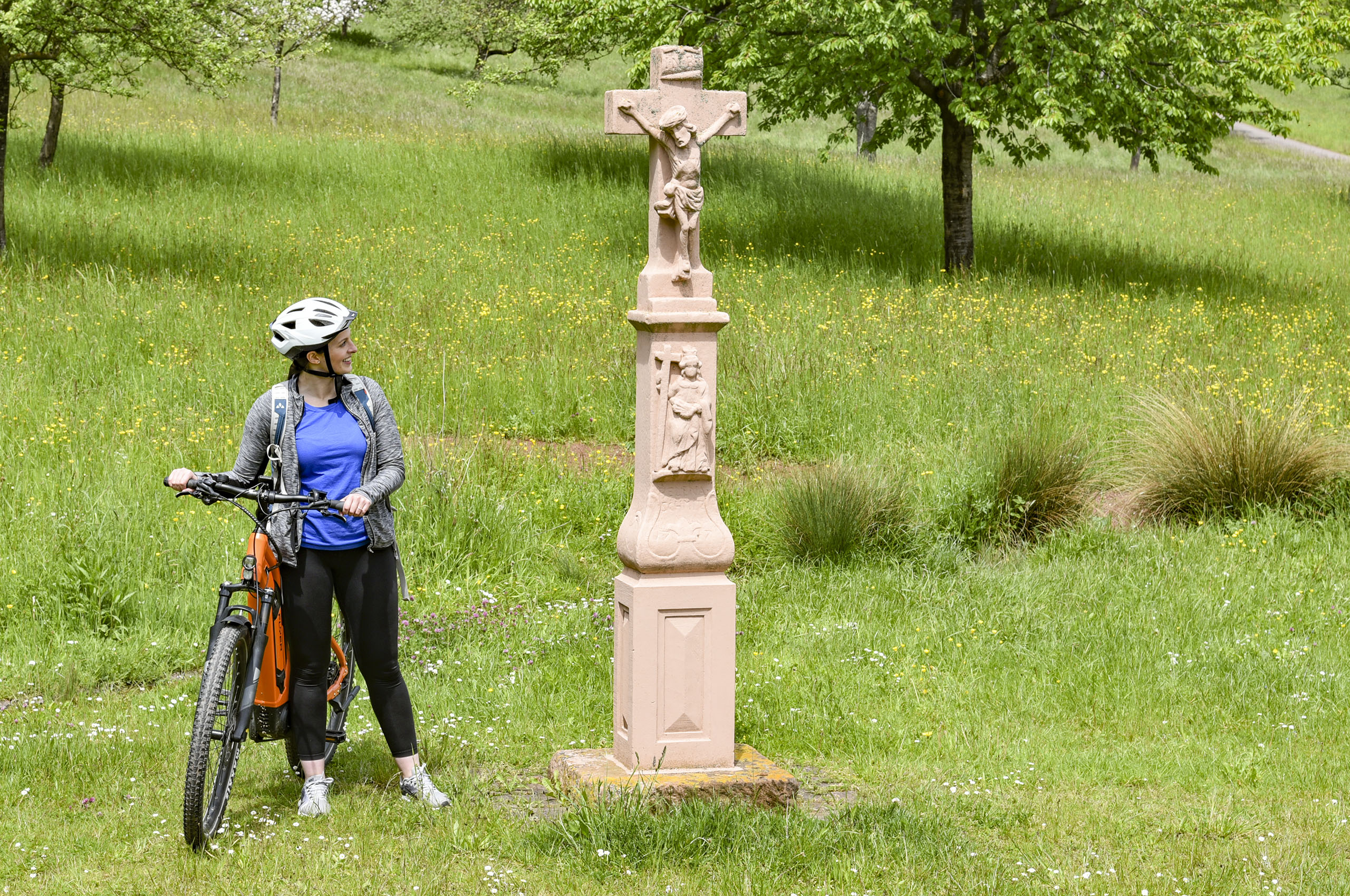Station:
Fintenkapelle
Bergweiler – Finten chapel The medieval Finten chapel (49° 58′ 14˝ / 6° 50′ 11˝ E) on the north-eastern outskirts of Bergweiler is a permanent port of call – a pilgrimage destination for concerned parents and pious people who come here to entrust themselves here to the Blessed Virgin Mary in supplication and prayer with worries about their offspring or the health of their children.
The Finten madonna is invoked to assist sick children and in cases of unfulfilled desire to have children. Originally, the weight of the sick child in a manger was measured out in grain to be used as a donation for the chapel. Numerous votive tablets inside the Finten chapel still attest to its function as a place of supplication. A small pulpit at the front is remarkable from an architectural point of view.
From 1741, it had become necessary for the clergyman to preach to the faithful gathered in the open field from this outdoor pulpit, as the chapel had become too small. The first mention of the Finten chapel can be found in 1656. Following a vow by married couple Hubertus and Elisabeth Finten, the chapel was rebuilt in baroque style in 1717.


“The fulfilment of the vow ended the curse of child mortality in the Finten family, which had worked for four generations. The origin of the curse lay in the murder of a roaming Landsknecht. The surviving father had committed it in revenge 13 years after the Finten family had been violated by Swedish mercenaries.”
In return for the chapel being transferred to the Catholic parish of Bergweiler in 1717, a solemn procession in honour of St. Helena from the parish church in Bergweiler to the Finten chapel takes place each year on the first Sunday in August. In 1981, the chapel was placed under protection as a cultural monument. In 2004, it was renovated by local volunteers to shine in renewed splendour. The Finten chapel is the landmark of the village and is lovingly maintained by the local community and the Catholic women’s and mothers’ association of Bergweiler.
Two old wayside crosses and the rebuilt Helenenquelle well can be found in the chapel yard. The Helena cross from 1717 on the left is one of the plague crosses that were erected in gratitude after the last wave of the plague had subsided and the turmoil of war in Europe slowly quieted down. The reason for the erection of the second one, a round-stemmed cross from 1888, the so-called “Herrmann cross” of Arenrath, has been lost to time. Its sandstone crucifix, which was lost during the war years, was replaced by a cross made of stainless steel. The well, the so-called Helenenquelle (St. Helena’s spring), was reconstructed here using a supply line of approximately 160 m length coming from the former spring location. It originally served the Finten estate as a deep well with overflow for water supply. The former location of the well and the former Finten estate, to which the Finten chapel originally belonged, lie below the embankment of the adjacent motorway.

Barockes Schaftkreuz aus rotem Sandstein, 18. Jh.
Quelle:
- Fintenkapelle (S. 1115ff) in Hesse, G. & Wiseniewski, A. (1990): Wittlich-Land – Geschichte einer Verbandsgemeinde zwischen Vulkaneifel und Mosel, VG-Chronik.
Love – care for your neighbour
The bowl of love The man who is wise, therefore, will see his life as more like a bowl than a canal. The canal simultaneously pours out what it receives; the bowl retains the water until it is filled, then discharges the overflow without loss to itself. You too must learn to await this fullness before pouring out your gifts, do not try to be more generous than God. The bowl resembles the fountain that runs to form a stream or spreads to form a pool only when its own waters are brimming over. The bowl is not ashamed to be no more lavish than the spring that fills it. You must imitate this process. First be filled, and then control the outpouring. The charity that is benign and prudent does not flow outwards until it abounds within. I cannot see myself being enriched by your wasting of your powers. For if you are mean to yourself, to whom will you be good? Help me out of your abundance if you have it; if not, then spare yourself the trouble.
Text: Bernard of Clairvaux (founding monk of the Cistercian monastery Himmerod)
